Acura ZDX 2012 Owner's Manual
Manufacturer: ACURA, Model Year: 2012, Model line: ZDX, Model: Acura ZDX 2012Pages: 370, PDF Size: 10.06 MB
Page 231 of 370

Continued229
uuWhen Driving uShifting
Driving
■Shift Lever Operation1Shift Lever Operation
NOTICEWhen you change the shift lever from (D to (R and
vice versa, come to a co mplete stop and keep the
brake pedal depressed.
Operating the shift lever before the vehicle has come
to a complete standstill ca n damage the transmission.
Use the shift lever position indicator to check the
lever position before pulling away.
Whichever position the shift lever is in when driving,
a blinking
( D indicator indicates a transmission
problem.
Avoid sudden acceleration and have the transmission
checked by a dealer as soon as possible.
The fuel supply may be cut off if you drive at engine
speeds in or over the ta chometer red zone (engine
speed limit). If this happen s, you may experience a
slight jolt.
It may not be possible to operate the shift lever if the
brake pedal is applied while the shift lever release
button is held down.
Depress the brake pedal first.
Tachometer’s red zone
Shift Lever Position Indicator
Depress the brake pedal and press
the shift lever release button to shift.
Shift without pressing the shift lever
release button.
Press the shift lever release button
and shift. M
(Sequential Shift mode) Indicator/
Gear Position Indicator
Page 232 of 370
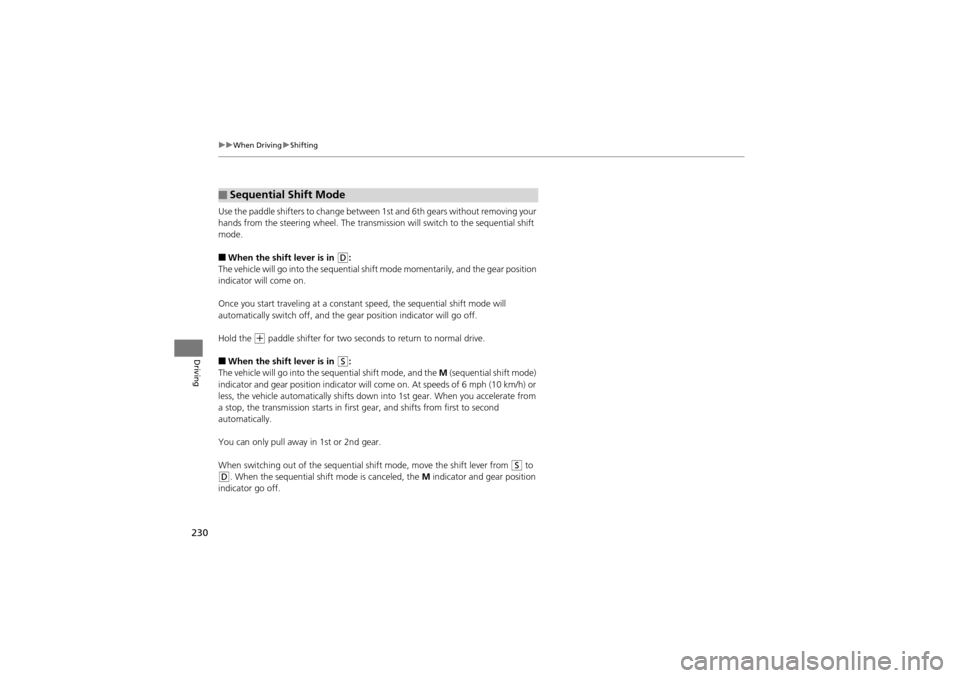
230
uuWhen Driving uShifting
Driving
Use the paddle shifters to change between 1st and 6th gears without removing your
hands from the steering wheel. The transmissi on will switch to the sequential shift
mode.
■When the shift lever is in D:
The vehicle will go into th e sequential shift mode mome ntarily, and the gear position
indicator will come on.
Once you start traveling at a constant speed, the sequential shift mode will
automatically switch off, and the gear position indicator will go off.
Hold the
+ paddle shifter for two second s to return to normal drive.
■When the shift lever is in S:
The vehicle will go into the sequential shift mode, and the M (sequential shift mode)
indicator and gear position indicator will come on. At speeds of 6 mph (10 km/h) or
less, the vehicle automatically shifts down into 1st gear. When you accelerate from
a stop, the transmission starts in first gear, and shifts from first to second
automatically.
You can only pull away in 1st or 2nd gear.
When switching out of the sequential shift mode, move the shift lever from
S to
D. When the sequential shift mode is canceled, the M indicator and gear position
indicator go off.
■Sequential Shift Mode
Page 233 of 370
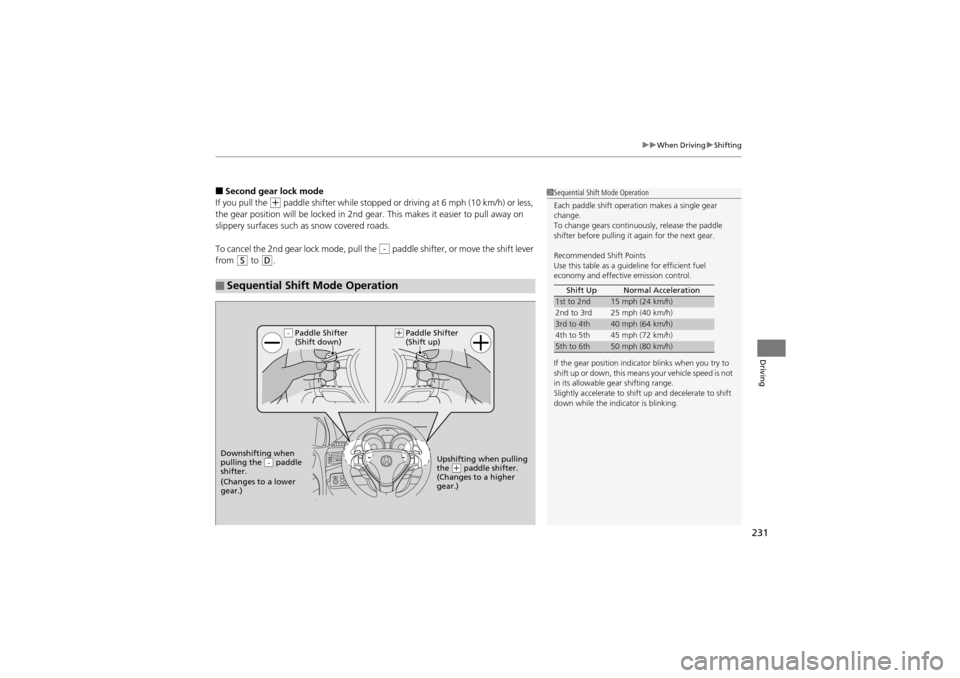
231
uuWhen Driving uShifting
Driving
■Second gear lock mode
If you pull the
+ paddle shifter while stopped or driv ing at 6 mph (10 km/h) or less,
the gear position will be locked in 2nd gear. This makes it easier to pull away on
slippery surfaces such as snow covered roads.
To cancel the 2nd gear lock mode, pull the paddle shifter, or move the shift lever
from
S to D.
■Sequential Shift Mode Operation
-
1 Sequential Shift Mode Operation
Each paddle shift operat ion makes a single gear
change.
To change gears continuously, release the paddle
shifter before pulling it again for the next gear.
Recommended Shift Points
Use this table as a guideline for efficient fuel
economy and effective emission control.
If the gear position indicator blinks when you try to
shift up or down, this means your vehicle speed is not
in its allowable gear shifting range.
Slightly accelerate to shift up and decelerate to shift
down while the indicator is blinking. Shift Up Normal Acceleration
1st to 2nd15 mph (24 km/h)
2nd to 3rd 25 mph (40 km/h)
3rd to 4th40 mph (64 km/h)
4th to 5th 45 mph (72 km/h)
5th to 6th50 mph (80 km/h)
Paddle Shifter
(Shift down)
Downshifting when
pulling the paddle
shifter.
(Changes to a lower
gear.)
-Upshifting when pulling
the (+ paddle shifter.
(Changes to a higher
gear.)
-(+
Paddle Shifter
(Shift up)
Page 234 of 370
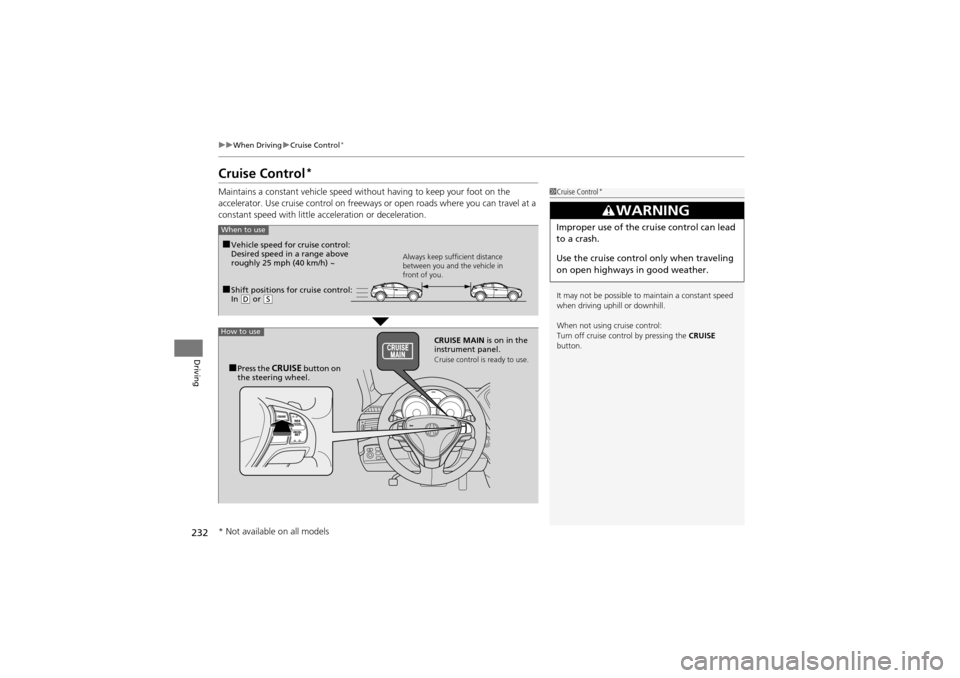
232
uuWhen Driving uCruise Control*
Driving
Cruise Control*
Maintains a constant vehicle speed with out having to keep your foot on the
accelerator. Use cruise control on freeways or open roads where you can travel at a
constant speed with little ac celeration or deceleration.1Cruise Control*
It may not be possible to maintain a constant speed
when driving uphill or downhill.
When not using cruise control:
Turn off cruise control by pressing the CRUISE
button.
3WARNING
Improper use of the cruise control can lead
to a crash.
Use the cruise control only when traveling
on open highways in good weather.
■Shift positions for cruise control:
In ( D or (S Always keep sufficient distance
between you and the vehicle in
front of you.
■Vehicle speed for cruise control:
Desired speed in a range above
roughly 25 mph (40 km/h) ~
CRUISE MAIN is on in the
instrument panel.
Cruise control is ready to use.■Press the CRUISE button on
the steering wheel.
How to use
When to use
* Not available on all models
Page 235 of 370
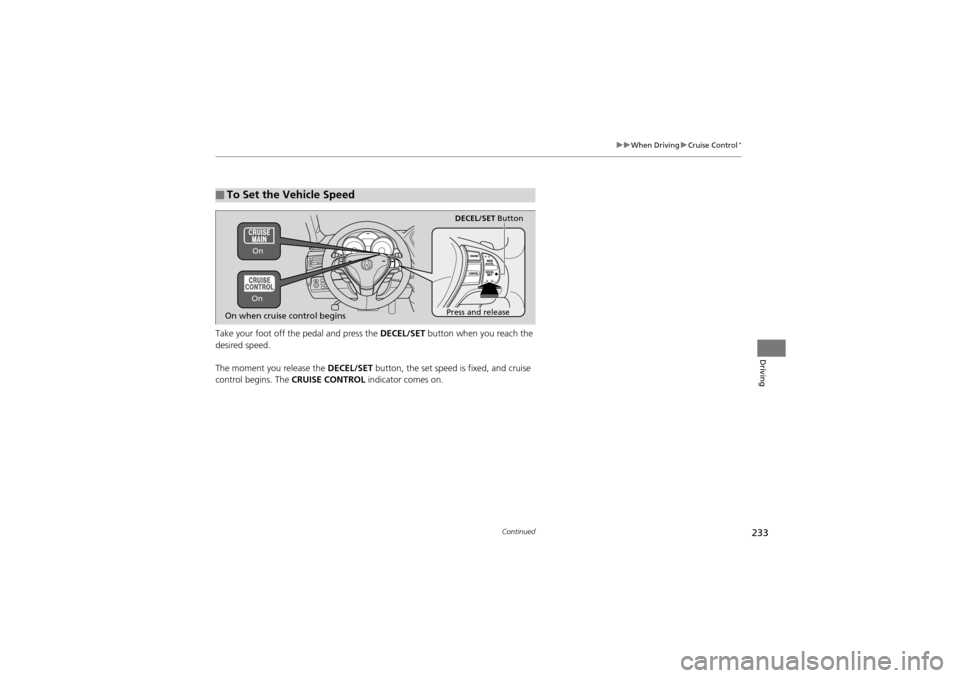
233
uuWhen Driving uCruise Control*
Continued
Driving
Take your foot off the pedal and press the DECEL/SET button when you reach the
desired speed.
The moment you release the DECEL/SET button, the set speed is fixed, and cruise
control begins. The CRUISE CONTROL indicator comes on.
■To Set the Vehicle Speed
DECEL/SET Button
On when cruise control beginsPress and release
On On
Page 236 of 370
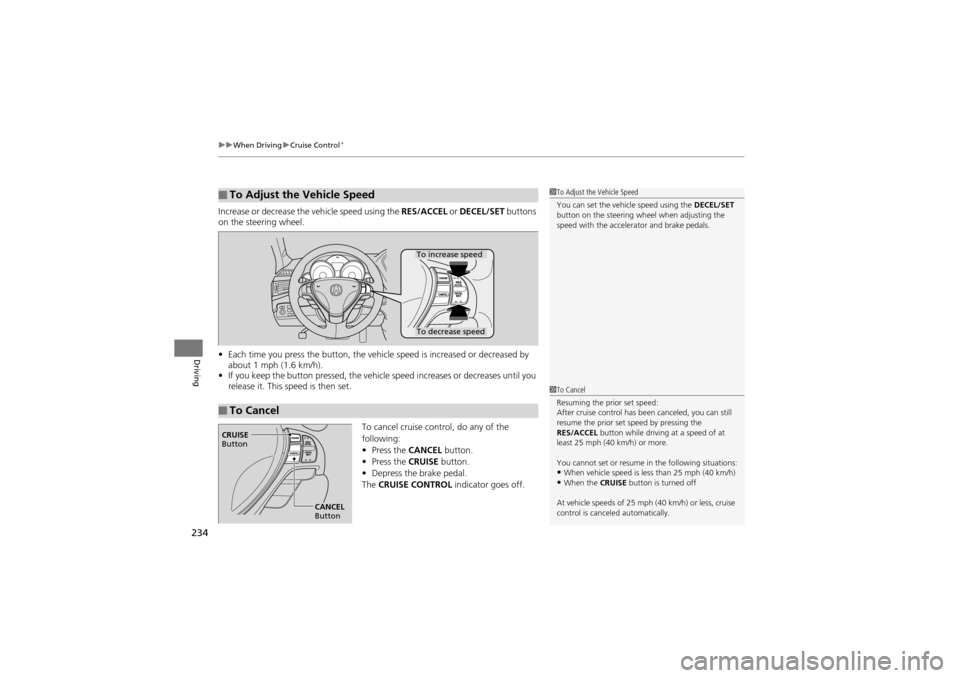
uuWhen Driving uCruise Control*
234
Driving
Increase or decrease the vehicle speed using the RES/ACCEL or DECEL/SET buttons
on the steering wheel.
• Each time you press the button, the vehicl e speed is increased or decreased by
about 1 mph (1.6 km/h).
• If you keep the button pressed, the vehicl e speed increases or decreases until you
release it. This speed is then set.
To cancel cruise control, do any of the
following:
•Press the CANCEL button.
• Press the CRUISE button.
• Depress the brake pedal.
The CRUISE CONTROL indicator goes off.
■To Adjust the Vehicle Speed1To Adjust the Vehicle Speed
You can set the vehicle speed using the DECEL/SET
button on the steering wh eel when adjusting the
speed with the accelera tor and brake pedals.
■To Cancel
To decrease speed
To increase speed
1To Cancel
Resuming the prior set speed:
After cruise control has b een canceled, you can still
resume the prior set speed by pressing the
RES/ACCEL button while driving at a speed of at
least 25 mph (40 km/h) or more.
You cannot set or resume in the following situations:
•When vehicle speed is less than 25 mph (40 km/h)•When the CRUISE button is turned off
At vehicle speeds of 25 mph (40 km/h) or less, cruise
control is canceled automatically.
CRUISE
Button
CANCEL
Button
Page 237 of 370
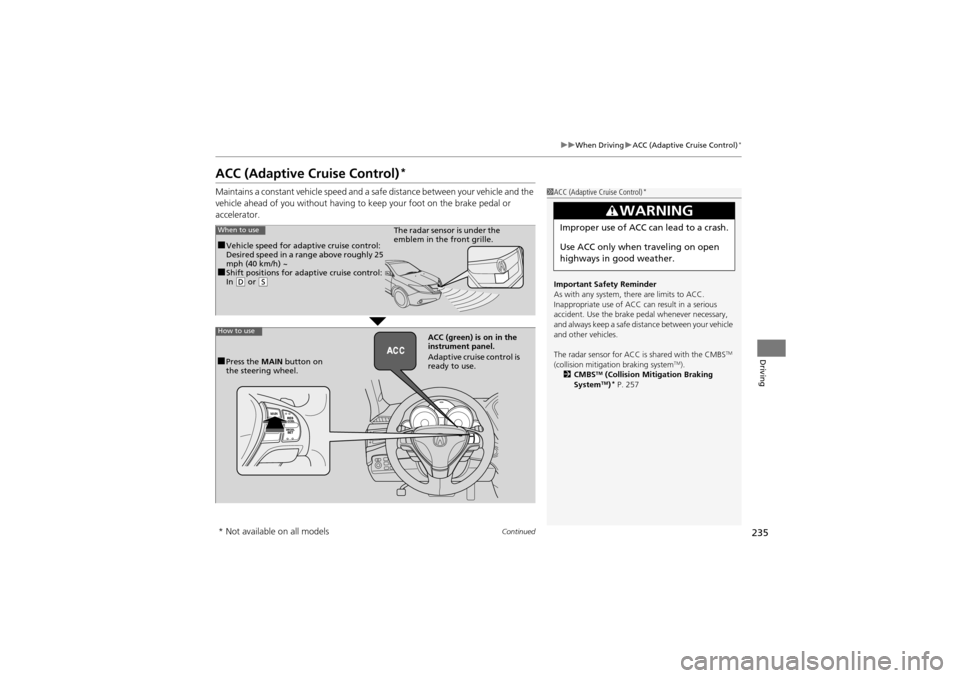
235
uuWhen Driving uACC (Adaptive Cruise Control)*
Continued
Driving
ACC (Adaptive Cruise Control)*
Maintains a constant vehicle speed and a safe distance between your vehicle and the
vehicle ahead of you without having to keep your foot on the brake pedal or
accelerator.1 ACC (Adaptive Cruise Control)*
Important Safety Reminder
As with any system, th ere are limits to ACC.
Inappropriate use of ACC can result in a serious
accident. Use the brake pedal whenever necessary,
and always keep a safe distance between your vehicle
and other vehicles.
The radar sensor for ACC is shared with the CMBS
TM
(collision mitigation braking systemTM).
2 CMBSTM (Collision Mitigation Braking
SystemTM)* P. 257
3WARNING
Improper use of ACC can lead to a crash.
Use ACC only when traveling on open
highways in good weather.When to use
■Vehicle speed for adaptive cruise control:
Desired speed in a range above roughly 25
mph (40 km/h) ~
■Shift positions for adaptive cruise control:
In ( D or (S
The radar sensor is under the
emblem in the front grille.
How to use
■Press the MAIN button on
the steering wheel. ACC (green) is
on in the
instrument panel.
Adaptive cruise control is
ready to use.
* Not available on all models
Page 238 of 370
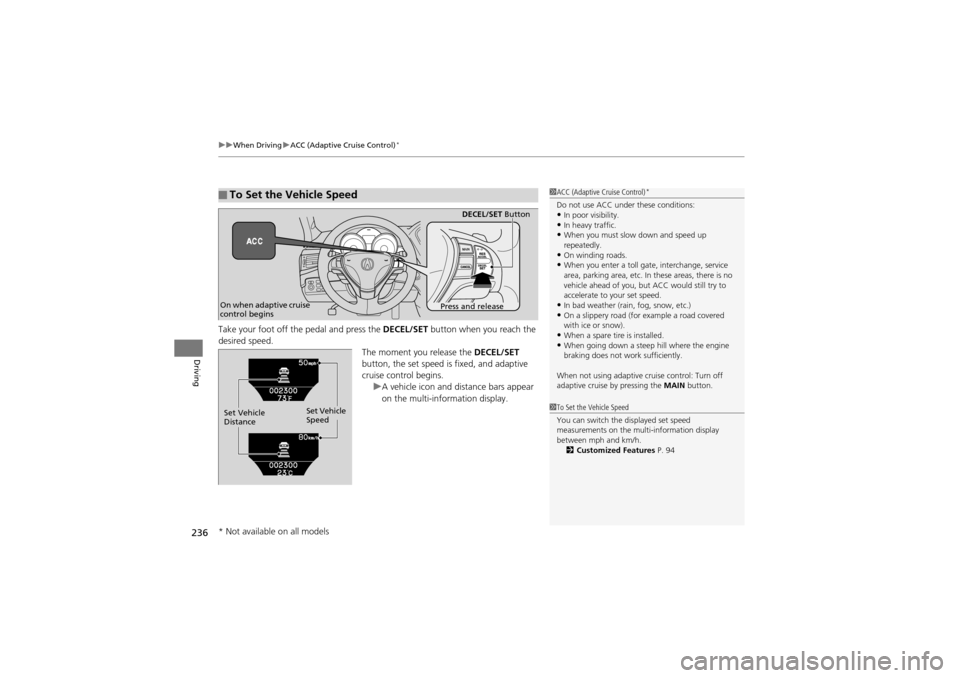
uuWhen Driving uACC (Adaptive Cruise Control)*
236
Driving
Take your foot off the pedal and press the DECEL/SET button when you reach the
desired speed. The moment you release the DECEL/SET
button, the set speed is fixed, and adaptive
cruise control begins. uA vehicle icon and distance bars appear
on the multi-information display.
■To Set the Vehicle Speed1ACC (Adaptive Cruise Control)*
Do not use ACC under these conditions:•In poor visibility.•In heavy traffic.•When you must slow down and speed up
repeatedly.
•On winding roads.•When you enter a toll gate, interchange, service
area, parking area, etc. In these areas, there is no
vehicle ahead of you, but ACC would still try to
accelerate to your set speed.
•In bad weather (rain, fog, snow, etc.)•On a slippery road (for example a road covered
with ice or snow).
•When a spare tire is installed.•When going down a steep hill where the engine
braking does not work sufficiently.
When not using adaptive cruise control: Turn off
adaptive cruise by pressing the MAIN button.
1To Set the Vehicle Speed
You can switch the displayed set speed
measurements on the multi-information display
between mph and km/h.
2 Customized Features P. 94
On when adaptive cruise
control begins Press and releaseDECEL/SET
Button
Set Vehicle
Speed
Set Vehicle
Distance
* Not available on all models
Page 239 of 370
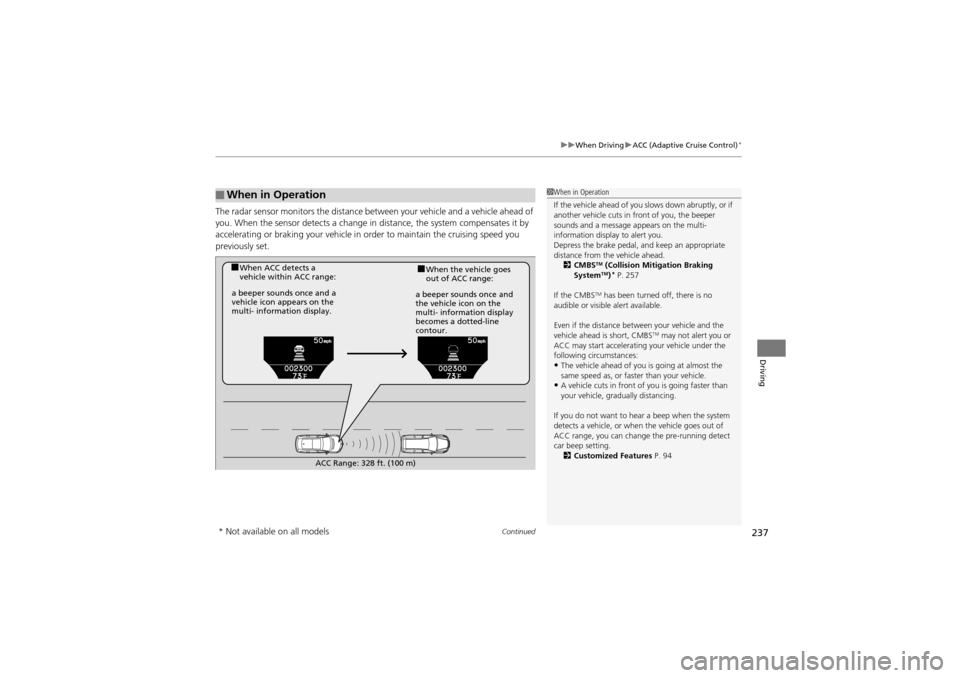
Continued237
uuWhen Driving uACC (Adaptive Cruise Control)*
Driving
The radar sensor monitors the distance be tween your vehicle and a vehicle ahead of
you. When the sensor detects a change in distance, the system compensates it by
accelerating or braking your vehicle in order to maintain the cruising speed you
previously set.
■When in Operation1 When in Operation
If the vehicle ahead of you slows down abruptly, or if
another vehicle cuts in front of you, the beeper
sounds and a message ap pears on the multi-
information display to alert you.
Depress the brake pedal, and keep an appropriate
distance from the vehicle ahead. 2 CMBS
TM (Collision Mitigation Braking
SystemTM)* P. 257
If the CMBS
TM has been turned off, there is no
audible or visible alert available.
Even if the distance between your vehicle and the
vehicle ahead is short, CMBS
TM may not alert you or
ACC may start accelerating your vehicle under the
following circumstances:
•The vehicle ahead of you is going at almost the
same speed as, or faster than your vehicle.
•A vehicle cuts in front of you is going faster than
your vehicle, gradually distancing.
If you do not want to hear a beep when the system
detects a vehicle, or when the vehicle goes out of
ACC range, you can change the pre-running detect
car beep setting. 2 Customized Features P. 94
■When ACC detects a
vehicle within ACC range:■When the vehicle goes
out of ACC range:
a beeper sounds once and a
vehicle icon appears on the
multi- information display. a beeper so
unds once and
the vehicle icon on the
multi- information display
becomes a dotted-line
contour.
ACC Range: 328 ft. (100 m)
* Not available on all models
Page 240 of 370
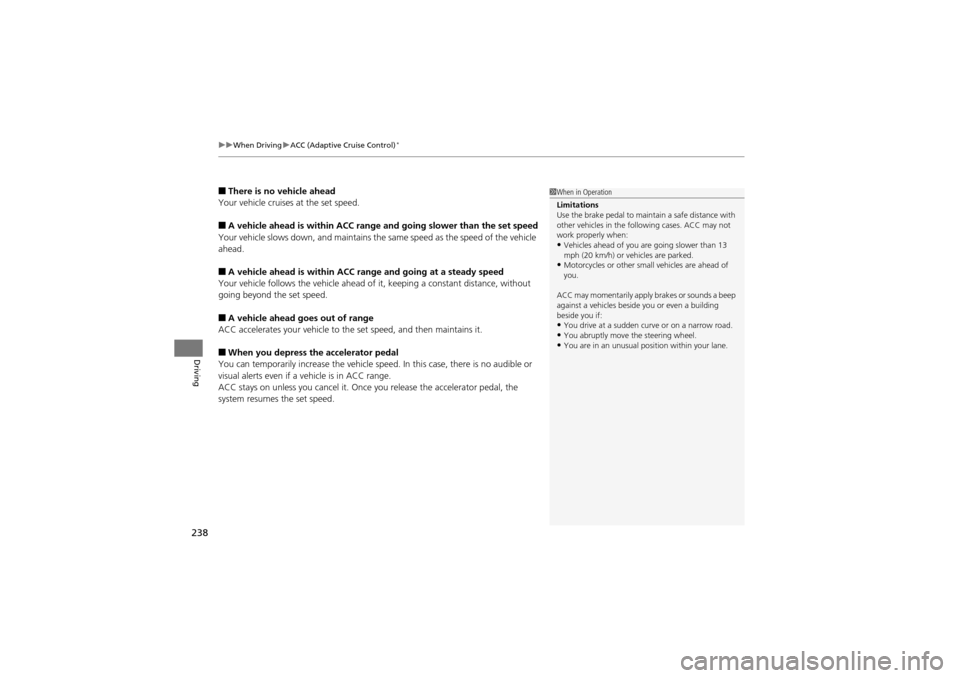
uuWhen Driving uACC (Adaptive Cruise Control)*
238
Driving
■There is no vehicle ahead
Your vehicle cruises at the set speed.
■A vehicle ahead is within ACC range and going slower than the set speed
Your vehicle slows down, and maintains the same speed as the speed of the vehicle
ahead.
■A vehicle ahead is within ACC range and going at a steady speed
Your vehicle follows the vehicle ahead of it, keeping a constant distance, without
going beyond the set speed.
■A vehicle ahead goes out of range
ACC accelerates your vehicle to the set speed, and then maintains it.
■When you depress the accelerator pedal
You can temporarily increase the vehicle speed . In this case, there is no audible or
visual alerts even if a vehicle is in ACC range.
ACC stays on unless you cancel it. Once you release the accelerator pedal, the
system resumes the set speed.
1 When in Operation
Limitations
Use the brake pedal to mainta in a safe distance with
other vehicles in the follo wing cases. ACC may not
work properly when:
•Vehicles ahead of you are going slower than 13
mph (20 km/h) or vehicles are parked.
•Motorcycles or other small vehicles are ahead of
you.
ACC may momentarily apply brakes or sounds a beep
against a vehicles beside you or even a building
beside you if:
•You drive at a sudden curve or on a narrow road.•You abruptly move the steering wheel.•You are in an unusual position within your lane.